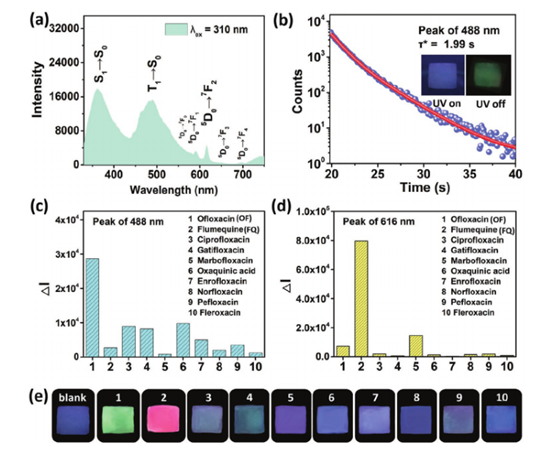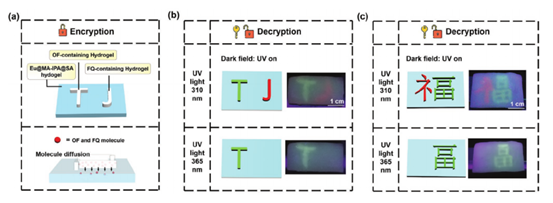Recently, Professor YAN Bing’s research team from the School of Chemical Science and Engineering has fabricated an Eu3+-functionalized HOF hydrogel film based on hydrogen-bonded organic framework (HOF). The film, able to emit a long afterglow of 1.99 seconds, can be used for the fluorescence detection of two quinolones (ofloxacin and flumequine). It can utilize the unique fluorescence response towards the two quinolones to achieve the information encryption, decryption and decoding. The research results were published online in Advanced Functional Materials (IF = 16.836) (DOI: 10.1002/adfm.202103321).

The research results of YAN Bing's research team on the application of rare-earth functionalized hydrogen-bonded organic framework-based hydrogel film materials were published in the internationally renowned journal Advanced Functional Materials.
Intelligence has been defined as the capability to sense, store, analyze, and respond to the surrounding environment or information. Intelligent luminescent materials (ILMs) have been a primary research focus of material science owing to their various intelligent optical applications such as fluorescence sensing, anticounterfeiting, bioimaging, fluorescent tags, optoelectronic devices, and microchip. For ILMs, fluorescence response is a crucial factor of endowing intelligence with luminescent materials, and it is often generated by optical signal output deriving from the evident luminescence change such as enhancement, quenching, and emission peak shift toward external chemical species and stimulus. Fluorescence sensing and chemical anticounterfeiting techniques can both be realized by fluorescence response. As a kind of ILMs, the luminescent Ln-functionalized HOF-based hydrogel (LnHOFHD) film is not only simple to prepare and easy to carry, but also can improve the security level of anticounterfeiting technique. Hence, there will be a promising application prospect to develop a dual-emitting LnHOFHD film.
On the basis of years of research on the functional assembly of photofunctional rare earth hybrid materials based on metal organic framework, Professor YAN's research team has gradually paid attention to the construction and functionalization of crystalline unit hybrid materials based on non-metallic organic framework. For example, a series of progresses has been made in the post-synthetic functionalization of covalent organic frameworks (J. M. Wang, B. Yan*, et al., Inorg. Chem. 2019, 58, 9956-9963; Anal. Chem. 2019, 91, 13183-13190; ACS Appl. Mater. Interface 2020, 12, 12990-12998; Anal. Chem. 2021, 93, 4308-4316; J. Mater. Chem. C 2021, accepted).

a) Emission spectrum of 1. b) RTP decay lifetime of 488 nm emission peak for 1. c) Histogram of T1→S0 emission of 1 in various QL solutions. d) Histogram of 5D0→7F0 emission of 1 in various QL solutions. e) Photographs of 1 taken out from various solutions under 310 nm UV lamp.
In this study, the research team successfully fabricated a HOF-based hydrogel with in situ synthesis method, then prepared a dual-emitting LnHOFHD film through the crosslinking reaction of Eu3+ ions and MA-IPA@SA hydrogel. The film shows a blue-green long afterglow after turning off the UV lamp, and the long afterglow lifetime reaches to 1.99 s. As fluorescent sensor, it exhibits good selectivity toward ofloxacin (OF) and flumequine (FQ), within ten kinds of quinolones based on the different fluorescence responses. The low detection limit gets to 0.443 ppm for OF and 0.114 ppm for FQ. The research team also utilize the energy transfer (ET) process to explore the luminescent response mechanism of the film toward OF and FQ in depth. The film also displays a great detectability toward OF and FQ in serum and urine systems. To further establish the optical applications of the film, the different fluorescence response mechanisms toward OF and FQ have been employed to fabricate fluorescent film array and excited-light controlling optical anticounterfeiting films, which can be utilized for multiple information encryption, decryption and decoding. This work not only proposes a simple method of preparing a new dual-emitting LnHOFHD film, but also provides a representative case about IMLs using for luminescent sensing and anticounterfeiting techniques.

a) The film anticounterfeiting platform based on 1, OF-, and FQ-containing hydrogel showing the “TJ” encryption process through molecule diffusion process. b) The film anticounterfeiting platform based on 1 showing the “TJ” decryption process (λex = 310 nm) and the “T” secondary decryption process (λex = 365 nm). c) The film anticounterfeiting platform based on 1 showing the “福” decryption process (λex = 310 nm) and the “畐” secondary decryption process (λex = 365 nm).
The research work is supported by the National Natural Science Foundation of China and the Development Science Foundation of Tongji University. While Professor YAN Bing is the corresponding author of the paper, his PhD students XU Xin and WANG Jinmin are the first and second authors.
Link to the paper: https://doi.org/10.1002/adfm.202103321
https://onlinelibrary.wiley.com/doi/10.1002/adfm.202103321